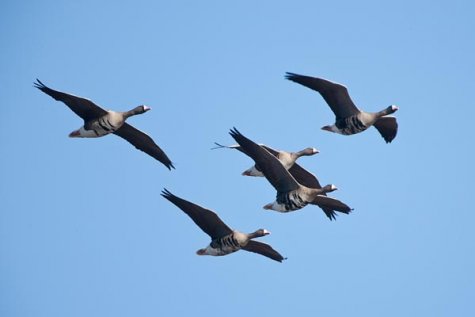About white-fronted geese
Photo: Arne Ader
Translation: Liis
Greater white-fronted geese
| Greater white-frotned goose |
Suur – laukhani
|
Anser albifrons |
| Lesser white-fronted goose |
Väike – laukhani
|
Anser erythropus |
The white patch at the base of the beak of white-fronted geese is well visible and distinguishes them from other geese when they migrate in mixed flocks with the bean geese. The white patch is quite large and goes from the base of the beak up to the forehead.
There are also the lesser white-breasted geese, but the ornithologists only see a few dozens of them during the autumn migration.
In a flight view the dark patches on the belly of the adult birds are characteristic. The beak is pink, as that of the greylag geese, and the feet orange as those of the bean geese. Compared to other geese the calls of the white-fronted geese are more melodious and clearly higher-pitched; it can be clearly heard.
Usually the large flocks of white-fronted geese pass across Estonia without stopping here; they don’t stay to forage in our coastal meadows. The migration is very intense, involving a couple of hundred thousand individual birds, and generally lasts only a few days.









